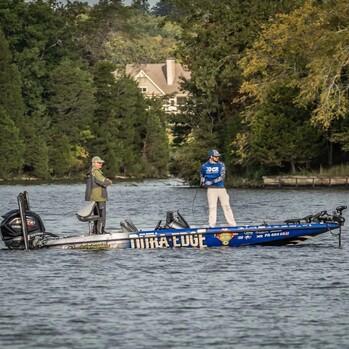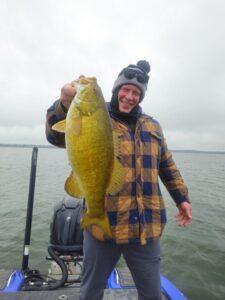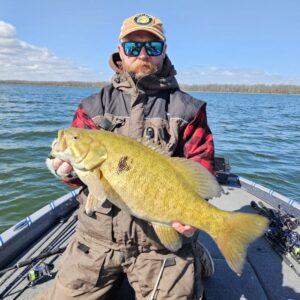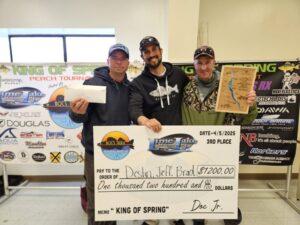Eight down, one to go. The Bassmaster EQ season, which spanned from February until October, is almost complete. We just wrapped up a back to back event swing in Tennessee and Missouri and I arrived home late Sunday evening. After a couple month hiatus this summer, we headed out to Watts Bar Lake in Kingston, Tennessee, to begin this end of season swing.
Going into Watts Bar Lake there were a few things I knew about the lake:
- That I really didn’t know much at all, never having been on that body of water before.
- It was a TVA (Tennessee River Authority) lake which meant current generation would be a big factor.
- It is an extremely tough fishery in the fall time from past tournament weights.
Inherently, those things aren’t bad. Not having much knowledge of the fishery would allow me to go out without too many preconceived notions. Knowing that it is a TVA controlled lake, I would have to know current generation schedules and bite windows. At least that was a controllable variable. And the fact that it was tough, actually made me more excited to fish the place. I enjoy the hardest tournaments, where the weights are low and it’s truly anybody’s game.
We stayed at Bob & Todd’s Fishing Lodge in Lenoir City, which was right near the Loudon dam that spills into Watts Bar Lake. I’ve met Bo Rice a handful of times, as my travel partner, Craig, has gone on striper fishing trips with him for about twenty years. Him and his son, Trey, were very hospitable and their lodge was extremely nice and affordable for myself and the West Virginia, North and South Carolina contingent we were staying with that week.
We mixed it up, launching there near the dam as well as up in Kingston and down the lake towards Lake Chickamauga. As advertised, I quickly realized it was going to be tough sledding. The upper river portion of the lake was harder for me to crack and the middle to lower end of the lake ended up suiting my style and skill set better. The first day I went to that lower section of the lake, we grinded hard, and didn’t find much. However, what we found would end up being very valuable. I fished shallow as is commonly good this time of year, mid-depth and deep and ended up finding the most consistent bite and quality in deeper water. I quickly shifted my efforts from beating the bank to graphing offshore looking for those needle in a haystack type areas. I was able to locate about four of those deep areas that would produce in the event. The best thing was, I had no company on any of them, except for my travel partner, Craig, since we share spots with each other.
Day one of the event I felt confident that I could catch a limit even in the tough conditions. The game plan was to start deep, then go shallow, then back deep again, attempting to hit the key parts of the best bites both deep and shallow. It went about as well as planned. We caught eight or so keepers (largemouth and spotted bass had to be 15”, while smallmouth had to be 18”). It was one of those days that things came together and most every decision panned out well. I ran new shallow areas and caught keepers, and adjusted positioning on offshore schools to keep catching them in heavier current. We even had one smallmouth that I measured two times at 18 1 ⁄ 8 ” and didn’t think anything of it. When I went shallow and filled a limit and began to cull, I deep hooked a solid keeper on a shakyhead. The fish was bleeding, but was at least 4 ounces bigger than my smallest fish at the time. The thing is, if a fish dies, you cannot get rid of it for a smaller one and will lose 4 ounces of weight per BASS rules for dead fish.
I ended up keeping it and checking on it frequently. I quickly realized it wasn’t going to make it. Poor timing, as I caught more cull fish that were two pounds or better that had to be thrown back or cull a bigger fish when I went offshore. Dang. Still, myself and my co-angler, Johnnie Garrett (grandfather of EQ Angler, John Garrett), who managed to get a keeper fish too, knew I had a very good bag. I had estimated about twelve pounds on BASSTrakk, while he gave me about a pound more, by his estimate. We rode back to weigh in feeling good about having a fun day out there. That tune would soon change at the bump tank (the place a BASS official checks the length of the fish and makes sure they are alive).
I conversed with other angler’s in line talking about our days, listening to the weights coming across the scales and realizing I may have had an even better day than I had thought. When I dumped my fish in the tank for the BASS official to check, his eyes got bigger and he gave me a fist bump, knowing it was a really good day on the water. That anticipation and excitement quickly turned to uncertainty as he flipped my smallmouth over and over again, putting it back in the water to keep it healthy, then trying again. The top of the smallmouth’s tail was long and pointy, while the bottom was more rounded. This went on with another BASS official coming over to inspect and myself saying that it touched on two different occasions. Nevertheless, it didn’t work out. We lost the probably three pound smallmouth as well as an additional 1.25 lbs in penalties for having a short fish and a dead one. If it didn’t touch, it was 17.999”, which was heartbreaking. Wow.
We ended up getting credit for the four other fish and after the additional penalties started off the event with four fish for 8-4. Fishing is the highest of the highs and the lowest of the lows. It’s amazing how things can change. I wondered, should I have thrown back that fish that was not doing well? Should I have thrown back the three pound smallmouth “just in case” in favor of a two pound largemouth? Decisions. Decisions. Ultimately, it all boils down to one thing. It’s on me. Regardless of what decisions, I did or didn’t make. The length of a certain fish or long term health considerations, it’s on me. That doesn’t make it any easier, but I can assure you one thing, being a victim doesn’t either. Now, some people have legitimate cases to feel victimized in life and in certain situations, but if you don’t quickly move on from that, it will hurt you more in the long run. Moral of the story, I messed up and now had to face the consequence of a largely wasted, but great day of fishing by Watts Bar standards.
Day two, I knew I needed to catch a big bag to get back up towards making the top 10 cut. My mindset changed from slow and steady to catch them and go swinging hard for some big bites. High risk, high reward type fishing. I began fishing my first offshore stop from day one and it was slow going. I slowly moved out and looked around with my Active Target, casting to individual suspended fish and hooking up with one that seemed to be a smallmouth, before it pulled free. Dang. It’s early though, and I have plenty of fish to target. Onto the next spot. Bang, bang. Two keepers made it to the boat in consecutive casts. The first probably two and a half pounds, the next a 15.5” keeper. We headed to our next best offshore spot down the lake a bit further and pulled up and caught some barely shorts (not keepers), then bang, another 15.5” keeper. It choked it, literally. That could be another problem, however, it wasn’t bleeding and seemed to be fine. I kept icing the livewells (oh yeah, it was still in the mid-80s) to help keep the fish happy and healthy. I checked the fish shortly after. Not looking good. Hmm. This situation seemed familiar. More ice, some Rejuvenade (fish care chemical) and we’ll check him again shortly. I decided to go shallow and try to fill a limit. We fished mostly new water again, quickly putting keeper number four in the boat, flipping a ⅜ oz Angler Tungsten Combat flipping weight in a laydown tree on the main lake with a 4/0 Owner Jungle flipping hook and Rage Bug. Sweet! It was still pretty early and I had a much longer day two to fish. I ran a couple more pockets and then landed on one adjacent to where I had three or four bites, the day prior. Within about ten minutes of throwing our True South V-Twin buzzbait, BAM! We had our fifth keeper. A solid 2.25 lb fish. I had lost a three pound largemouth under a dock right near there the day prior and went to line up and make the same cast again with our shakyhead. Sure enough, I pick up and it’s swimming away. I rear back into him and it feels heavy for a second, nothing. A day later and a day smarter (laughs). We hit a few more shallow areas before heading back to our A-grade offshore spot. Within a couple casts, bam, another two plus pounder. It culled. The problem was, our smallest fish had since deceased. Dang it. We culled on our number four fish and kept catching them. The next ones were smaller unfortunately, but they were biting with increased current generation. I knew I had at least ten pounds which was above average in that event, but with the day prior’s mishaps, I would at least need a truly big bite (4+ lb) in order to jump back up near where we needed to be. So, I left in search of it.
I went to places I’d seen 18-20” smallmouth and fished those areas, with nothing. I hit bluffs where I’d caught solid keepers, but only caught shorts and white bass. I hit docks, laydown banks and even went up the Tennessee in search of that elusive big bite. I ran into Craig up there, who said he needed a keeper. I told him they were biting on that offshore spot and he quickly caught a two pounder and proceeded to lose a four pound smallmouth…I guess I should have stayed there. Hindsight is always 20/20.
I worked my way up towards our takeoff point in Kingston, but never could upgrade. We weighed in 10-8 on day two and ended up missing a check by 7 ounces. It was tough, as we finished 45th, but really, other than the mishap day one, I enjoyed Watts Bar. It’s a tough, stingy fishery, but we were able to catch a good bit of fish and enough keepers each day to have a chance at day three. It definitely stung, but the good thing was, we didn’t have much time to think about it, as we were back on the road the next day for the ten hour drive to Lake of the Ozarks in Osage Beach, MO.
On a side note, my co-angler practice partner, Sakae Ushio, ended up winning the event on the co-side. He’s been on a tear winning a lot of Opens and Toyota Series events and I can attest, he’s a finesse guru. We had some great conversations throughout practice and the tournament days regarding strategy, new finesse techniques and our setups. There is a reason he’s been so successful lately and I’m happy he picked up another W!
Lake of the Ozarks was another fishery I had never been to, which offered some intrigue. I knew that it was full of docks (something like 40,000 span the lake) to fish as well as many rocky bluffs and brush piles angler’s put in the lake to add fish catching cover. I also knew that it would be fall transition and the fish and bait would be on the move. A two day BFL that ended on our first day of practice took about 16 lbs a day to win and was littered with the legendary Hibdon’s that made a name for themselves on that lake. This all meant, it was fairly tough, judging by the overall weights and inconsistency in weights each day of the event by the best locals that fish the place. There were something like forty anglers that didn’t even weigh a bass. I knew we’d need to catch them a bit better than the BFL weights to have a chance to do well, but overall, after practice I knew it would be tough to be consistent.
My first day of practice was so-so. I caught about 10-12 lbs as I tried to figure out what was going on in the lake. The next couple days I felt like I started to put something together with my topwater and jig bites. The thing was, it felt like you had to run a lot of water in order to get those bites. As practice ebbed and flowed, I saw some great quality fish, boating a 6.5 lber, as well as a number of 4-5 lb fish. Could I duplicate it? They seemed to come in similar general areas, but oftentimes, you had no idea when that bite would come. I had a very loose game plan that involved covering water with a topwater, throwing at any targets I could find, while slowing down and skipping a jig on certain docks and throwing it at offshore brush in and around those same areas. The general five miles of lake that I got some of those bigger bites, I decided to start my tournament around there and jump around hitting new water that looked good in between and around it.
We were a middle flight so we had a solidly long day to figure them out. The conditions had been mostly sunny in practice and we had a storm blow through that night with cloudy conditions for the first day of the event. We had one similar day in practice and it was my toughest one. I felt like the sun helped position my fish and the clouds scattered them, making them harder to effectively target. Our first couple stops up the Osage River yielded no luck, other than some short fish, before we hooked up and landed our first close to two pound keeper on our buzzbait, running a rocky shoreline. It’s always nice getting that first bite to try and hone in on what’s going on at that particular time. Ok, that storm probably messed them up some and that later morning, early afternoon bite would be crucial. We bided our time, running and gunning, covering water, catching shorts and small keepers. Our second keeper came on a Jackall Chop Cut prop bait, probably 2.25 lbs. Not bad, as long as we could get two or three quality bites throughout the day. I felt like they would come, but overall they didn’t. That window did open though and I started getting bites, running my pattern. Boating a 3.5 lber, missing one about three pounds that I threw a jig too off the end of a dock and filling a limit, albeit with a 12.5” spotted bass keeper. Our co-angler for the day, Scott, chipped in with two keepers on a drop shot for a decent start to his event. We never got our quality bites, that we really were banking on and ended up with a limit for 10-5. It was a weird day, but I felt like the quality would have to bite for me sooner or later. I decided to do a 180 though and turned the opposite direction out of the PB2 boat ramp and went up towards the Gravois arm of the lake.
It seemed like a good decision as my first stop yielded a quality bite right off the rip. I skipped my jig way back in a boat lift, set the hook and proceeded to pull a good 3.25-3.5 lb fish up over a beam. It opened its mouth, jumped and threw my jig. Dang. So early again, no big deal. I ran more similar areas of new water, catching shorts and small keepers along the way. The sun came up a bit and I went to fishing some offshore brush piles. I hit a stretch that had a bunch and quickly boated a keeper on the jig. Afterwards, I caught a fish out of about every other one nearby, but most were just short, before bowing up on a solid one. It came up, jumped and spit my jig. No thanks, I don’t like that flavor (laughs). We kept running new water and the buzzbait bite began to pick up as I boated a couple more keepers to fill a limit, again with a small 12.5” spotted bass (15” minimum on largemouth and smallmouth, 12” minimum of spotted bass there). I made a small cull or two on the jig and a brush hog. I began fishing more offshore as I worked my way back towards the PB2 ramp. I caught fish, but still not the right quality. I’d go back to the docks and brush but still nothing bigger. Dang. We brought in another slightly smaller limit that went 9-1. No excuses, it just didn’t happen. Fall events especially can be challenging as things are constantly in flux. I remember in 2020 when our Elite Series season was pushed back because of COVID and we had the four fall events. It was super hard to be consistent. I started well at Guntersville day one, then did not make the right adjustments on day two, had a top ten at Santee, followed by a bomb at Chickamauga (that knocked me out of the Classic cut) and a solid 30th place finish and a good check at Lake Fork with a really challenging bite. Fall can be fun, but it can also throw even the locals and guys that know a lake well for a loop.
We’ve got one more event left to cap our season down in the Sunshine State. Next week we make the trek down to the Harris Chain to chase some big, fall transition bass in one of my favorite states in the U.S. Florida is another animal and adds a whole different dynamic to bass fishing, but add in the typical fall dynamic and it should be a formidable challenge. The local tournament weights have been down some, but the fish to catch an absolute mega bag still swim in those tannic stained waters. I’ve been to the Harris Chain a handful of times, but never in the fall. I’m really looking forward to the challenge and am going down there with an open mind and will be looking to finish this up and down season on the right note. Tightlines everyone!




